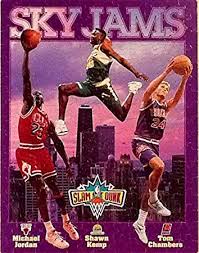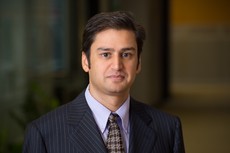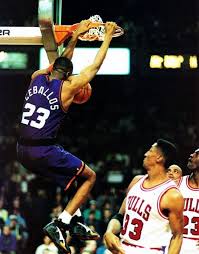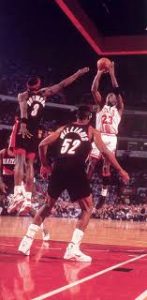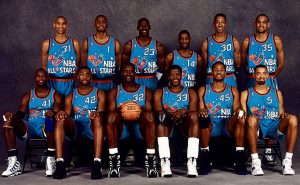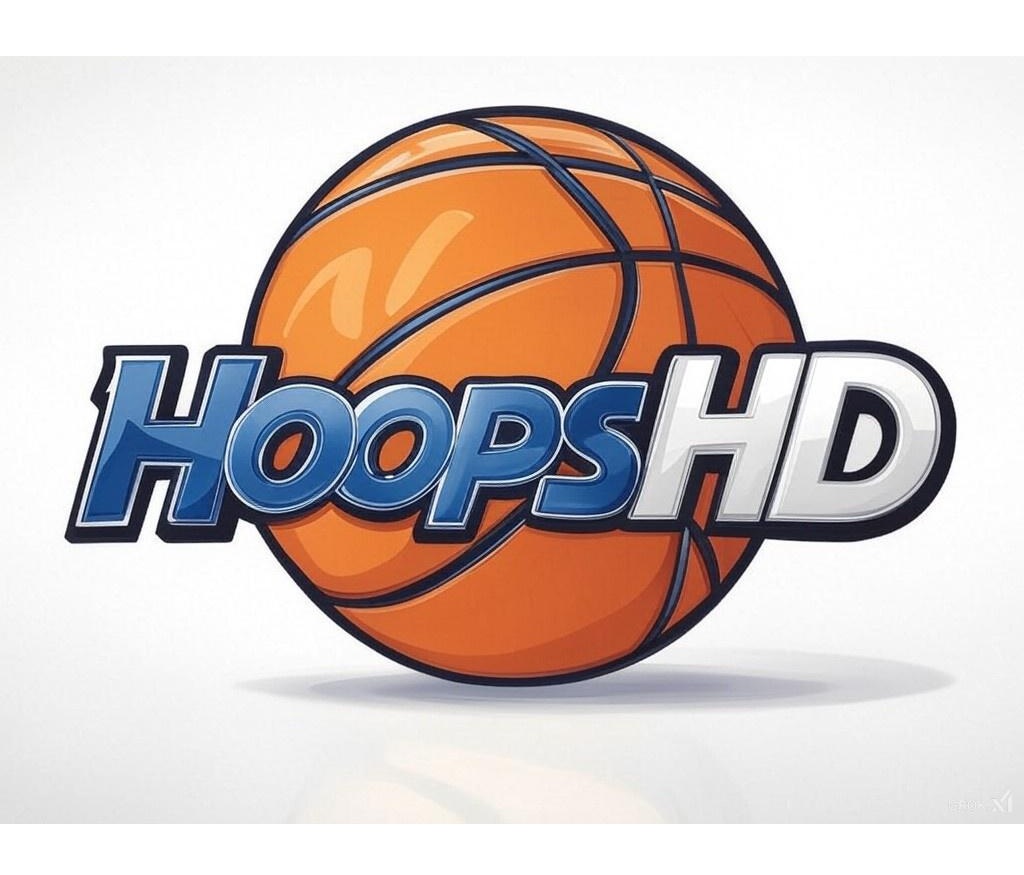When the NCAA tourney got canceled in March we entered a whole new world, which included a sports void the likes of which we have never seen before. The fine folks at ESPN came to the rescue in mid-April with “The Last Dance”, a 10-part miniseries about the 1998 Chicago Bulls and their quest to win a 6th NBA title in an 8-year span before Coach Phil Jackson and most of his star players all went their separate ways. While it has been comforting to spend the past several Sunday nights with behind-the-scenes stories from Steve Kerr/Scottie Pippen/Dennis Rodman, the star of the show as always is Michael Jordan. Even though the documentary concluded on May 17th, HoopsHD’s Jon Teitel has dug through his archives and discovered oodles of unpublished interviews about Jordan’s career, from his early days as the leading scorer for team USA at the 1983 Pan Am Games to a 55-PT playoff performance during Chicago’s final title run in 1998. We continue our trip down memory lane by chatting with Jay Guidinger about losing to Jordan in the 1993 Eastern Conference Semifinals and having Phil Jackson constantly complain about him to the officials.
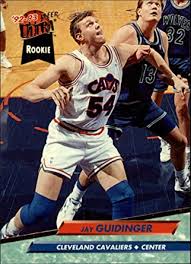
You were born/raised in Wisconsin: what made you choose Minnesota Duluth? I was born/raised in Milwaukee. In February of my senior season in high school I tore the ACL in my left knee so my college choice was essentially made for me when that injury occurred. It is interesting to note that I was aspiring to play D-1 basketball. Marquette came to watch me practice the week prior to me tearing my ACL. After practice I was essentially offered a “preferred walk-on” opportunity…but the interest from the D-1 level evaporated entirely after the knee injury. At the time of my injury my older brother Jeff was a senior playing at Minnesota Duluth. Head coach Dale Race and his staff had been heavily recruiting me since my junior year of high school but time and again I delayed making a commitment to UMD. After my knee injury I thought that I had lost all my options. I was truly grateful that Coach Race was still willing to give me an opportunity to play college basketball despite the severity of my knee injury. My high school career was very-average-to-boring and I did not achieve any conference awards or other recognition that I recall. However, Coach Race saw something in me that I did not see in myself: I am eternally grateful to him for the opportunity that he gave me.
You started each of your 126 games in college and set school records with 1953 PTS/1095 REB/195 BLK: what is the key to being a good post player? Footwork/spacing/timing/balance. A great set of hands helps, as well as the ability to communicate with those hands, and also your facial expressions. Balance is important: not just your own physical balance (which is important in the post) but understanding how to keep the floor balanced by how you move. Being a “good post player” requires you to be a “good basketball player”. Just like dribbling/shooting/passing are so important to being considered a well-rounded triple-threat basketball player, being comfortable while playing with your back to the basket, utilizing your pivot foot from a stationary position, and understanding weak side movement/timing (without the ball) are equally significant to being a great basketball player. Everyone needs to pay attention to spacing and timing. Anyone that finds themselves playing “in the post” needs to be comfortable making basketball decisions, both with and without the ball, while not seeing the basket. A great pass out of the post area that shifts the defense is a great offensive weapon. Weak side screens on the “help defense” creates havoc for the defense. Those teams that take the time to instruct all of their players on fundamental footwork and body positioning used in the post area to seal a defender/sustain gaps/create diversions are teams that will compete at a high level. The fundamental footwork/spacing/timing/balance for working in the post area are transferable to setting effective screens. This is another area of playing in the post that I thought I did well at. The better the screen/screener interaction, the more opportunities I created for myself on offense. Not just interior screening but also at the 3-PT line as well as in the open court. It is a thing of beauty when a primary ball handler and screener interact effectively: the defense is helpless when the timing and spacing is synchronized. This takes practice, patience, and communication (both verbal and non-verbal).
You were a 3-time NAIA All-American center and the 1st person to be named Northern Sun Intercollegiate Conference POY for 3 straight seasons: what did it mean to you to receive such outstanding honors? I was, and still am, very grateful for that recognition. My individual success was a byproduct of the culture created by Dale Race, his staff, and the quality of the players I was fortunate to call my teammates. As I said earlier, I received no high school awards/honors/recognition from either my conference or my state. Not that I thought I deserved any: just that I was not accustomed to being viewed as such a good player. Honestly, at times I was a bit embarrassed by all of the individual recognition. I truly could not have received these individual honors had I not played with really good, high IQ, basketball players and had excellent coaches. We worked together as a team at a high level and achieved many wins. Our coach Dale Race always told us: “The greatest team you will ever be on is the one that you call home and with whomever you call family. If you are not pulling your weight and doing your part for that team, it is going to show up on the basketball court and in the classroom. Be a great team player at home first and the rest will take care of itself.” That is a philosophy that has stuck with me to this day and is a concept that I have shared with as many young players as often as I could.
After having reconstructive surgery on both of your knees prior to your initial tryout you signed with Cleveland in October of 1992 as an undrafted rookie: how bad were your knees, and what did it mean to you to sign a pro contract? Signing an NBA contract was something that I never ever seriously thought was in the realm of possibility for me. When it happened, and under the circumstances in which it happened, it was an unbelievable experience. I tore my right ACL coming out of high school…and then 4 years later at the NBA Portsmouth Invitational camp I tore my left ACL. Most people might think, “You had a good run kid but it is time to hang it up”. My knees were probably worse than I thought at the time but I never thought about having “bad knees”. Don’t get me wrong: I was disappointed/devastated each time that I tore my ACL. I shed many tears and felt sorry for myself. Each time I felt “so close” to knowing whether I was “good enough” but when I thought that I was about to find out I kept having setbacks. I think that is what drove me: I needed to know whether I was good enough to actually play at the highest level in the world with the best players in the world. I always felt that I could improve: I just had to stay healthy. That mindset is probably what got me through the adversity of rehab. What I did not realize was how much time I was spending and how hard I was working just to be healthy/strong enough to play at a high level. I simply wanted to compete WITH the best: I did not come into Veteran Camp wondering who I was going to beat out. I was focused on 2 things: showing them that I could play the game the right way at a high level with the best players, and trying to be the last guy they cut. I guess I accomplished 1 of those 2 goals: they did not cut me on the last day! I was focused on understanding and playing the game at the highest level with the world’s best players. I was fortunate to have Lenny Wilkens as a head coach and Wayne Embry as a general manager: they both have brilliant basketball minds and are tremendous human beings. I think they saw how hard I was working to play the game at a high level with my teammates and that I was not worried about showcasing my game. They knew what they needed in a player for the position so they eventually signed me and I was fortunate to be healthy enough (both mentally/physically) to accept the position. In the end my mindset of “needing to know” seemed to work for me. There are other people that helped me get the Cavs Veteran Camp tryout: I am forever grateful to both my late agent (Don DeJardin) as well as a Cavs scout whose name escapes me.
In the decisive Game 4 of the 1993 Eastern Conference Semifinals vs. Chicago, Michael Jordan made the series-sweeping shot at the buzzer: what was it like to face the 2-time defending champs, and did you think the shot was going in? Playing against the Bulls in the old Chicago Stadium was magical. As for the shot going in, I was hopeful that he would miss it but my prayers were not answered. I was fortunate to play in the old Forum in LA, the old Boston Garden, and Madison Square Garden in NYC. The history of those places coupled with the great players from that era of the NBA was like winning the lottery. I talk about being on the same court as Jordan and actually playing in an official game with him but I do not have many words that can capture that feeling or memory other than “grateful” for an experience that very few people can claim. However, I had to make sure not to be in awe too much because we had a job to do. Every day I took the court for practice with my Cavs teammates I was among some of the best, most consistent, highest-producing players in the NBA. I was not dwelling on the fact that I was on the world’s largest basketball stage because I thought that it would last for many more years: I thought that I would have more time in the NBA than I actually ended up getting.
You played in 32 games with the Cavaliers followed by a few games in the CBA with the Rapid City Thrillers: what is your favorite memory from your time in the NBA, and what was the biggest difference between the NBA and CBA? Everything about being with the Cavs for two seasons (and the CBA Thrillers for a brief stint) was a great chapter in my life. I played for Mike Fratello in my second year with the Cavs: another great NBA mind. Both Lenny/Mike had amazing assistant coaches who were all great to be around. Eric Musselman coached me with the Thrillers. Although I only had a brief stint with the Thrillers Eric kept me focused and playing at a high level, which eventually got me back to the NBA with the Cavs. I have probably forgotten more special moments than I will ever remember but occasionally something will randomly come back to me: I am grateful that they make me smile rather than frown. I was blessed to have Lenny teach me NBA basketball but also privileged to listen to his stories from his time in NBA, the people he knew, and the social problems he faced. I played with 2 great teammates that passed away too soon in Bobby Phills/John “Hot Rod” Williams. In 2 short years with the Cavs I could go down the list of teammates/coaches/front office staff/facility personnel and think of a memory that makes me smile. What stands out to me was a game against the Bulls in Chicago during my 2nd season with the Cavs with Hubie Brown calling the game on TV. I played significant minutes that game and if my memory is correct we won. I know that I was frustrating Horace Grant/Phil Jackson because they were constantly complaining about me to the officials. More than likely they probably thought Fratello pulled me out the stands, gave me $20 and a uniform, and said, “You got 6 fouls: go use them!” The reality was that I just played the game, got in Horace’s way, disrupted the triangle offense, and tried to do whatever I could to help us win. After the game in the concourse, Hubie (whom I do not know) randomly walked up to me and said something like, “You did a good job tonight kid: I like the way you play the game so keep working hard because you can play in this league” and then walked away. I never met Hubie before that encounter and unfortunately I have never had the chance to speak with him again. I do recall that I thanked him before he walked away. Interestingly, it would only be a few days later that my basketball career would be over forever.
After retiring from basketball you spent a few years as a college assistant coach, and you currently work as a Vice President/General Manager for Lamar Advertising: how did you like coaching, and how do you like advertising? I love basketball. I love being around the players, the game strategy, and the business of the game at all levels (both men’s and women’s). Since basketball did so much for me as a player, I naturally thought that I would become a coach after my playing career ended. What has worked out in terms of the path that I walked and am currently walking is God’s plan. I was blessed to have opportunities to stay in coaching as a career but opportunities outside of basketball also presented themselves to me. Why? I have no explanation but by the Grace of God. I guess that I pursued these opportunities away from basketball because I “needed to know” if I was good enough to be successful without basketball. Lamar Advertising is a great company to work for and work with. Advertising in general is a lot like training to be an athlete: if you do not constantly train/practice you will lose your conditioning and your skills will diminish. You cannot stockpile fitness and skill. In that same regard you cannot “store” market awareness. The less you promote your brand and/or offerings, the fewer opportunities you will have.
In 2001 you were inducted into your school’s Hall of Fame: where does that rank among the highlights of your career? This was a great honor and a testament to the players/coaches I had around me during my college years. It came long after my playing career ended when someone would be thinking about receiving an award. It is very special because it helped me put into perspective all of the great things that had happened in my life up to that point and how I would use those experiences to live out the rest of my life. My acceptance speech was titled “Realizing potential”. I am on a journey now to help my children and anyone else I am associated with to realize their potential in whatever way that may be.
Your wife Khai played basketball at your alma mater and your daughter Jinda plays basketball at Western Illinois: who is the best athlete in the family? I have to be careful with this answer! Athletically, our children are much better athletes than either me or my wife. They are better basketball players than we were at the same ages, and arguably better students. Hopefully that has something to do with us helping our kids realize their potential. I could not be more grateful/proud/blessed to be happily married for 25 years and have 3 healthy children. My daughter Jinda is in her 2nd year with Western Illinois as a pre-med student who plays basketball. She played a lot as a freshman and put up good numbers on both ends of the floor based on her minutes played. This year she has been nursing a nagging muscle strain/tendinitis all season. She played through the injury in a supporting role this season and the Leathernecks were 1 of the best teams in the Summit League. My oldest son Gabe is a senior at Central York High School in York, PA. We relocated to York from Pewaukee, WI after Gabe’s sophomore year in 2018. He earned a starting spot on the varsity for the Pewaukee Pirates, which is the same school that the Watt family attended….as in JJ/Derek/TJ! Gabe is closing out his senior campaign and has decided to go to college at St. John’s University in Minnesota. The timing of my relocation was not the best for Gabe’s college exposure but at least he will play college basketball somewhere. Central York was ranked 12th in the state of Pennsylvania. Gabe is 6’5” with a 6’8” wingspan and can score at all 3 levels on the court. He has great hops and hands and is a defensive mastermind who can guard the 1-4 spots (and the 5 spot if needed). Our youngest son Greg is finishing 8th grade and has played on the Central York freshman team the last 2 years. He is 6’5” at age 14 and is very skilled: he handles the ball so well, which he gets from his mom. He runs the point and dishes like a true point guard: also from his mother. He has college 3-PT range, a nice mid-range game, and great footwork in the low post. He is a threat at all 3 levels.
When people look back on your career, how do you want to be remembered the most? Hopefully they will say, “Good ball player, great teammate!”

